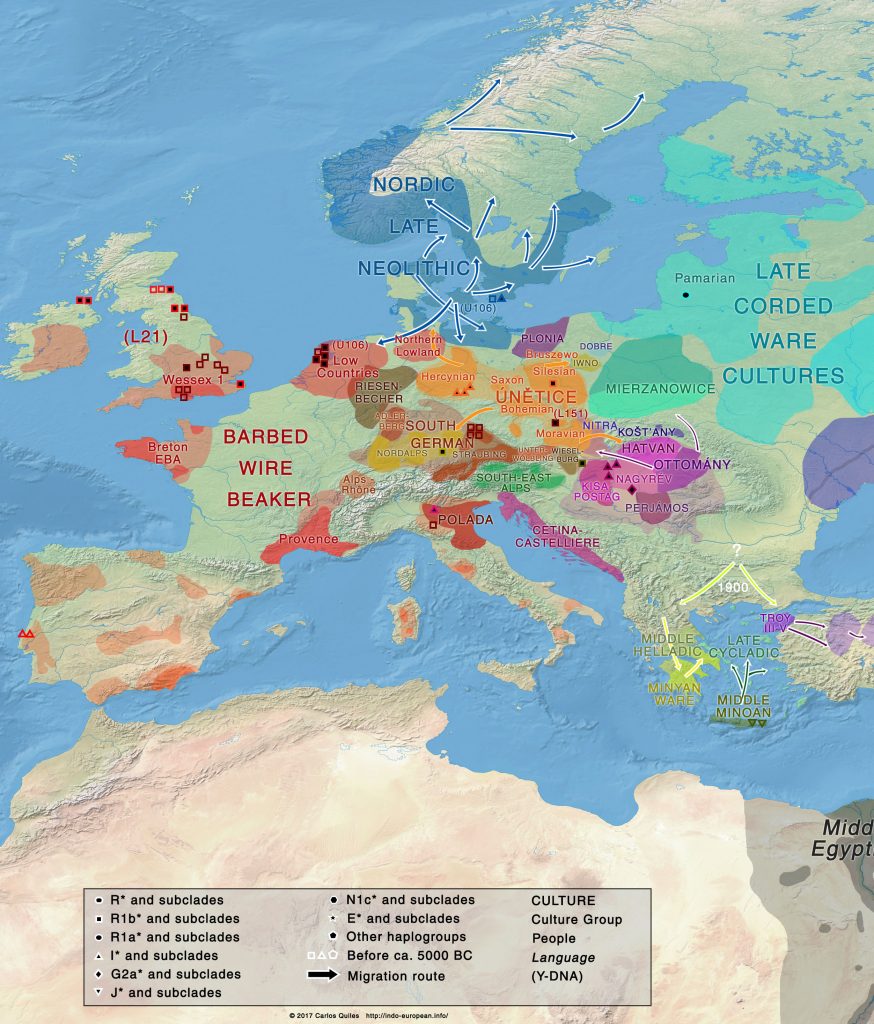I wrote recently about the newly created Indo-European Corded Ware Theory group, which represents today the last dying effort to sustain the outdated model of the ‘Kurgan peoples’.
Archaeology and Linguistics (like Genetics) keeps slowly but relentlessly rejecting all the Kurgan model‘s foundations, safe for the steppe origin of Indo-European expansion.
The book Language and Prehistory of the Indo-European Peoples. A Cross-Disciplinary perspective. Eds. A. Hyllested, B.N. Whitehead, Th. Olander and B. Anette. Copenhagen Studies in Indo-European. Museum Tusculanum Press, Copenhagen, has been recently published (December 2017).
In it, Christopher Prescott contributes to the history of Indo-European migrations to Scandinavia and the formation of a common Nordic language, ancestral to Proto-Germanic.
A draft of his chapter is downloadable in Academia.edu: Dramatic beginnings of Norway’s history? Archaeology and Indo-Europeanization.
Here are some excerpts from the text:
Thus archaeology can deal with the question of Indo-Europeans through material culture, and archaeology can contribute to unraveling the events leading up to the fact that Indo-European languages were spread from the Indian Ocean to the northwestern European Arctic in pre- and proto-history. In 1995, Prescott and Walderhaug tentatively argued that a dramatic transformation took place in Norway around the Late Neolithic (2350 BCE), and that the swift nature of this transition was tied to the initial Indo-Europeanization of southern and coastal Norway, at least to Trøndelag and perhaps as far north as Troms. Although this interpretation cannot be “proven” in any positivist sense of the word (though aDNA and isotope studies have added a new layer of relevant data), in light of the last ten years of research and excavations, it is has become an increasingly reasonable hypothesis (e.g., Engedal 2002, Fari 2006, Håland and Håland 2000, Kristiansen 2004, Melheim 2006, Østmo 1996, also Kvalø 2007, Larsson 1997).
(…)
The Late Neolithic transformation gives rise to a cultural platform where most of southerly Norway is incorporated into the Nordic sphere. Interaction is no longer over borders, rather within a common cultural arena. Locally, the cultural institutions provide a base for the continued dynamic development through the Late Neolithic and Bronze Age. On a larger geographic and historical scale, incorporation into this field of interaction opens even the most peripheral parts of southern Norway to the streams of culture and events that shape Europe’s Bronze Age history, for example those originating from within Unetice, Tumulus Culture, Urnfeld and Hallstatt.
(…)
Changes in Scandinavia Norway are linked to wider transformations in Europe. Culturally, both Corded Ware Battle Axe and the Bell Beaker are important referential easterly and westerly European cultural horizons. Both these horizons affect and transform Northern Europe, so developments in Norway are not isolated affairs. Needless to say, though often regarded as Indo-European, the processes leading to and the affect of these cultural horizons is discussed for other parts of Europe as well (Mallory 1989:243ff).
Though there are reasonable arguments to assign both Corded Ware groups and bell Beaker groups Indo-European affiliations, the Corded Ware/Battle Axe horizon did not transform large parts of the Scandinavian Peninsula, nor can this horizon be identifies as the source of the practices, forms and institutions that characterize the ensuing Late Neolithic and Bronze Age. The Bell Beaker/early Late Neolithic, however, represents a source and beginning of these institution and practices, exhibits continuity to the following metal age periods and integrated most of Northern Europe’s Nordic region into a set of interaction fields. This happened around 2400 BCE, at the MNB to LN transition.
Though much is tentative and conjecture, multiple sources indicate that ideology, cosmology, myths social organization and probably language were Indo-European in the Bronze Age, and the development of the Bronze Age is rooted in the preceding Late Neolithic. Though the evidence also indicates that the initial Indo-European encounters, indeed “colliding worlds”, were probably experienced in the Middle Neolithic B, the archaeological record points to the time around transition to the Late Neolithic as the chronologically defining threshold for the entrenchment of an Indo-European platform throughout what would become the Nordic Bronze Age region in Norway. The Late Neolithic is therefore the most likely candidate for the introduction of the foundation for economic, social and ideological institutions, that is Giddens’ “deeply layered structure[s]”, that are fundamental to the development of the region’s identities, also ethnic, in the millennia to come.

Mind you, not that these actual archaeological and linguistic models will deter anyone from supporting ancestry-based tentative sketches of a fictional ‘kurgan people’ that became outdated almost 60 years ago now – especially if they fit certain desires of ancestral ethnolinguistic identification with modern populations…
Related:
- Indo-European demic diffusion model, 3rd edition (revised October 2017)
- The renewed ‘Kurgan model’ of Kristian Kristiansen and the Danish school: “The Indo-European Corded Ware Theory”
- Globular Amphora not linked to Pontic steppe migrants – more data against Kristiansen’s Kurgan model of Indo-European expansion
- Correlation does not mean causation: the damage of the ‘Yamnaya ancestral component’, and the ‘Future America’ hypothesis
- New Ukraine Eneolithic sample from late Sredni Stog, near homeland of the Corded Ware culture
- Something is very wrong with models based on the so-called ‘steppe admixture’ – and archaeologists are catching up
- Germanic–Balto-Slavic and Satem (‘Indo-Slavonic’) dialect revisionism by amateur geneticists, or why R1a lineages *must* have spoken Proto-Indo-European
- Heyd, Mallory, and Prescott were right about Bell Beakers